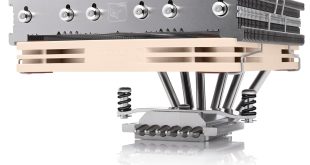The first installation step is to attach the backplate and push through the four screws. In the manual, Phanteks advises a specific screw orientation to balance the moment of force which is exhibited on the hexagonal heads.
A solid plastic spacer is placed around each mounting screw to provide a medium upon which the pair of support bars can sit.
The support bars can be secured in the horizontal or vertical alignment to provide flexibility with the TC12DX's mounting orientation. To mount the heatsink in the horizontal direction, users should align the mounting bars horizontally. Mounting the bars vertically will allow the TC12DX to use the more common vertical orientation.
A long screwdriver is required to fasten the TC12DX's pair of spring-loaded screws to the support bars. This procedure requires the fans to be removed, so don't install them before the cooler is securely mounted.
Each of the four noise-damping rubber strips can be stuck to the TC12DX heatsink once it is installed, or before, if preferred.
Fast, simple and secure, we are very impressed by the method that Phanteks has employed to mount its PH-TC12DX heatsink.
Preparing the fans for installation upon the heatsink requires a plastic fan clip adapter to be pushed through the mounting hole at each corner. Once in position, each end of the metal fan clip is directed through the adapter's hole to provide a secure fastening method.
Attaching the fan clips is tricky at first – users are required to align the plastic adapter with a directed end of the metal clip. The end result is a secure connection, but the exact method is a little ambiguous and takes some getting used to.
Each fan can be positioned at a user-specified height on the heatsink which is great for obtaining extra clearance for tall RAM modules or other interferences. The connection between heatsink and fan is very secure; these 120mm units aren't going anywhere that you don't want them to.
Wide enough to overhang the VRM area, Phanteks' PH-TC12DX has the potential to cause interference with large VRM heatsinks. Thankfully, the cooler isn't wide enough to pass the motherboard's upper edge meaning that it will not be fouled by roof fans in compact, mid-tower cases.
RAM clearance is a strength for the TC12DX. Even with the front fan installed at its ideal height, there is plenty of room to install tall RAM modules such as Patriot's Viper 3. On our Asus P8Z77-V motherboard, the front fan didn't even reach the DIMM slots.
Although we completed testing in NZXT's original Phantom, the Phanteks PH-TC12DX looks very attractive when installed in the Gun Metal version of NZXT's Phantom 820.
 KitGuru KitGuru.net – Tech News | Hardware News | Hardware Reviews | IOS | Mobile | Gaming | Graphics Cards
KitGuru KitGuru.net – Tech News | Hardware News | Hardware Reviews | IOS | Mobile | Gaming | Graphics Cards












